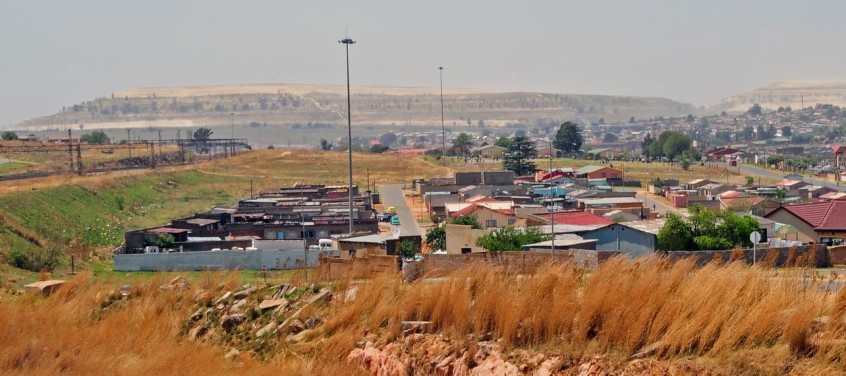We just had a few days in Soweto, cradle of the anti-apartheid movement in South Africa. These days it’s like dropping into Cannon’s Creek or Otara – modest housing but comfortable in the main, with electricity, water and sewerage, and well lit streets – certainly miles above what we’ve just been experiencing in Madagascar and Tanzania over the last month, and of course light years better than the hostels in the township for black workers that were its origin. Indeed the transport infrastructure around this city of 4 million is really modern, due in no small part to the awesome football stadium built here for the 2011 World Cup, and in which we saw the All Blacks strut their stuff last Saturday.
But by far the most impressive aspect of our stay was mixing with the people. Our digs were on Walter Sisulu Square right in the heart of Kliptown, Soweto’s oldest and arguably most run-down sector. But there’s a real feeling of optimism amongst the citizens across Soweto, whether they’re adherents of the small Zulu-originated Inkatha Freedom Party, the Xhosa-originating and ruling ANC, or the major opposition party the Democratic Alliance. Two major soccer clubs are based here – the Zulu-supported Kaiser Chiefs (with 16 million supporters! I’m jealous) and the Xhosa-supported Orlando Pirates, placed 1st and 2nd respectively right now in the South African Premier League.
It is clear that the lot of black people has vastly improved since the days of the racist government ended in the early 1990’s, with housing, community amenities, health and education all on the up now. The gap for most from the lifestyles of whites remains horrendous but progress has begun for sure. Of course the country isn’t without its challenges and the Rand is struggling again, now just under 9 per US dollar. It’s a far cry from the days before regime change when that rate was 2 per dollar. No wonder people trying to get their capital out of South Africa during the turbulent years after the change took such a hit. More recently the slowdown in Europe and Asia has hit South Africa’s mineral and agricultural exports, much as it has commodity exporters everywhere.
But the country has struggled for years now to attract foreign capital to fuel its economic machine and for good reason. It is yet to shake off the legacy of the racist regime in several ways and that concerns investors who adjudge it will have no choice but to address some painful issues before it gets on a sustainable footing.
The recent furore in the mining industry whose profits remain based on cheap black labour and much of it, exposes the sharp contrast say to conditions in the mines of Australia. How long can that situation remain? South Africa’s half million mine workers have in large part missed out on the absolute boom in revenue that the commodities boom delivered while the owners, many foreign, have creamed it. Trickle down has been a joke. The resultant unrest has led to police massacre of striking workers.
The other observation a visitor can make readily is that many South African white ordinary households still have black domestic workers on low remuneration and there’s no formal protection of these worker’s rights. Not only does this prolong entrenched racist attitudes the white population is infamous for, but it promises to be a touchstone of black disgust and discontent in time.
It’s easy to be revolted by these disparities that are the legacy of the racist regime but a lot more difficult to figure out how to correct them. Unemployment in South Africa is 25%, so far this century it has bounced between 20 and 30%. The difference to Spain and Greece of course is the level of unemployment benefit, so adding to unemployment by decreeing better conditions for black workers in the mines or correcting the obvious exploitation of black domestic workers, is not an attractive option. Rather, the government is trying to counter the racist legacy in an orderly fashion through its Black Economic Empowerment programme by positively discriminating toward non-white citizens via training, economic development grants, employment, skills development, socioeconomic development and so on. It is a sensible and measured approach and is showing some great results in terms of the building base of skilled and educated non-white people.
But it is slow and financial markets worry about the risk of disturbances along the way. Hence the readiness to risk capital by investing in the new South Africa remains fragile. The atrocities at the mines fuel that reticence. Building an equitable society, encouraging and enabling the white population to emerge from its racism as well as overcoming its fear, and all the while opening opportunity for the vast bulk of this country of 50 million, is a massive challenge. But you have to say the country is well on the way.
We took great heart from the attitudes, the optimism and exuberance of the people of Soweto we mixed with – from local political activists, to the taxi drivers, domestic workers and retailers. Life is still hard, it was horrible but it has got better and they know their country is extremely rich and that getting the distribution of wealth more equitable is happening but it must be orderly for everyone’s sake. I certainly would invest in such a country.

